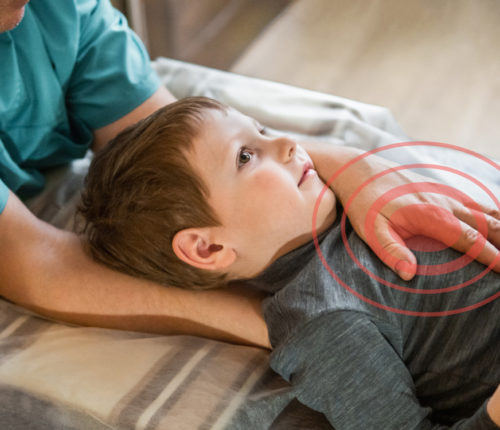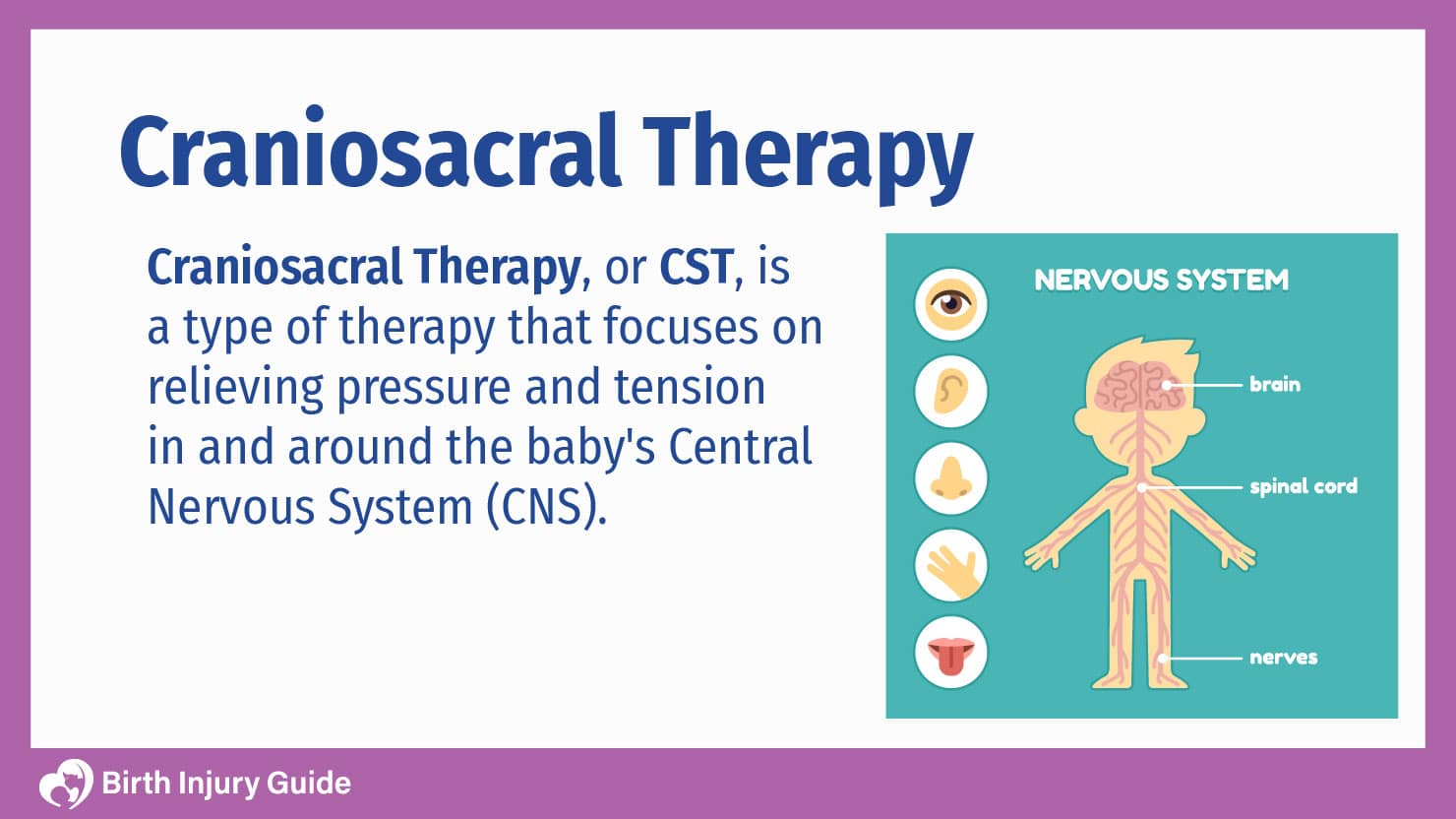
Craniosacral Therapy
Craniosacral therapy (CST) is a relatively new treatment that can be useful for infants who have experienced head trauma as well as a plethora of other birth injuries or events. It is often used for infants who experienced a difficult delivery.
Aside from injuries, CST is also effective for an array of other common problems that babies experience, including nursing and feeding problems, colic, teething issues and more.
About Craniosacral Therapy

CST involves massaging and lightly touching the bones around the skull using a highly specialized, hands-on, therapeutic technique in order to minimize pain, promote growth and immunity, and help babies recover from birth trauma. Physicians and therapists who specialize in CST state that there is a link between the lower part of the back (sacrum and spinal cord) to the fluids in the head (around the brain). Since these two areas are connected, they control a lot of the body’s actions. With CST, these areas can be massaged/lightly touched to reduce blockage and normalize the body and its ability to heal.
CST is also believed to relieve migraines and headaches, eye problems, hyperactivity, jaw issues, lack of coordination and ear infections. It may also relieve colic in infants, constipation, IBS, chronic pain and more. For adults, ACS suggests that it’s a beneficial form of therapy for cancer patients.
Types of Infant Cranial Injuries
During birth, the bones of the infants’ skulls move to enable the baby’s head to change its shape to fit through the birth canal and then the mother’s pelvis. The cranium bones may override each other in order to accommodate the birth process. Known as compression/decompression, it’s a normal process, and the bones usually move back into place naturally. However, in some instances, especially if an infant is pulled too harshly/improperly, unnatural damage may occur to the bones, and in turn, they may fail to heal and/or fuse properly. Traumatic cephalohematoma is just one example of such an injury.
As a result, what “should” be normal can lead to a host of problems, such as motor impairment, breathing problems, digestive issues and more.
Infants who are delivered via C-section may also be at risk for cranial injuries. In fact, studies suggest that babies born via C-section have more abnormal craniosacral evaluations when compared to infants born via vaginal delivery. This may be in part due to the C-section experience being more abrupt. In addition, when babies are delivered via C-section, they don’t go through the normal process of the cranial compression/decompression, which can result in skull constrictions.
How CST Helps Infants
Feeding Issues
Infants who struggle with properly latching or those who cannot or are unwilling to nurse can greatly benefit from CST. However, before starting therapy, a complete evaluation by the baby’s pediatrician needs to be done to determine what’s causing the feeding problem. Common issues are problems that arise due to birth injuries, congenital issues, neurological problems and/or after effects of drugs used before the infant’s birth.
In some cases, an infant could have been fed artificially with tubes or other means that created an aversion to feeding. It’s important to look into all aspects of the baby’s health when looking for the cause of breastfeeding or feeding problems.
CST can also be beneficial for babies who do not open their mouth wide enough to properly latch on during feeding. When this occurs, it may be possible to help by asking a physician or therapist about proper positioning during feeding to help the baby latch on. However, if proper techniques do not remedy the problem, CST may be beneficial.
“Craniosacral therapy eases the tightness in the baby’s mouth, head and neck, leading to breastfeeding success. Birth also affects the alignment of the baby’s head and body. CST aligns the body structurally and gets all the systems working properly — eating, pooping, sleeping,” says CST therapist, Barbara Coon, LMT.
Lip or Tongue Ties
CST has shown to be highly beneficial with infants with lip and/or tongue ties. CST typically treats infants pre- as well as post-revisions. In these instances CST helps the infant improve their oral range of motion and prepares the infant for proper latching/feeding.
Birth Trauma
Birth trauma can easily cause damage to the baby’s head or spine. As mentioned earlier, a difficult vaginal birth, a C-section birth, the use of a vacuum extractor or forceps, being delivered in the breech position, or an infant with an unusually large head are common reasons that birth trauma occurs. These kinds of injuries during birth can result in pressure being placed on cranial nerves, particularly the nerves that control the mouth.
Cranial Issues
As mentioned earlier, infants may experience injuries that fail to heal, especially during a traumatic delivery. However, studies suggest that infants who get CST, especially during the first weeks of life, have a good chance of the treatment being effective in healing misplaced cranial bones.
Other conditions that CST can help treat include:
- Vomiting
- Seizures
- Fine motor problems
- Cervical torticollis
- Cerebral palsy
- Down’s Syndrome
- ADD or ADHD
- Erb’s palsy
- Colic
- Excessive fussiness
- Klumpke’s palsy
- Reflux
- Constipation
- Teething problems
- Acid reflux
- Misshapen head
- Ear pain
- Sensory issues
- Gross motor mobility issues
- Sleep issues
What Happens in a Typical CST Session?
In a pediatric CST session, infants are placed on a massage table, in the therapist’s lap or in the parent’s lap. The goal is to first ensure that the baby is as comfortable and relaxed as possible. Afterwards, the treatment portion of the session typically consists of hands-on, rhythmic massage across the baby’s skull, jaw, mouth area and temples.
CST sessions generally make babies at ease, which in turn, comforts the mother. So in essence, in many cases, both mom and baby are being treated at the same time.
The hands-on treatment tends to be very light. It will generally never cause any pain to the infant as no manipulation is ever used. Typical sessions last anywhere from a half-hour to an hour. The duration depends on the therapist and the issues the baby is having.
What Happens After a CST Session?
Many infants will sleep for quite a while after a session, which is normal. Sometimes, infants may smile more often and seem deeply relaxed. Some may cry more often after a session, which is also considered normal as treatments tend to release emotions. This usually subsides within a few days.
Are There Any Complications Associated with CST?
Some studies suggest that CST may make matters worse for infants who have brain damage. However, there is not enough current information to indicate how accurate this may be. Additionally, some experts feel that depending on the diagnosis, infants should not undergo CST at all, and suggest that patients be at least two years of age before starting treatment. Again, more research is needed to determine if this is a valid claim. If you have any questions about craniosacral therapy for your baby, it’s important to consult with your physician beforehand.



